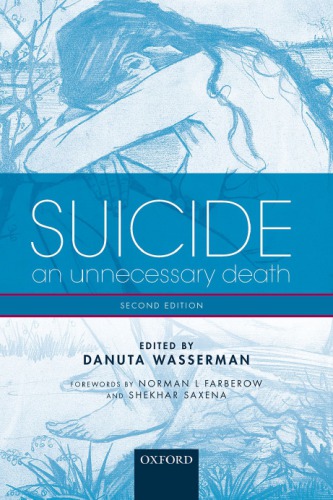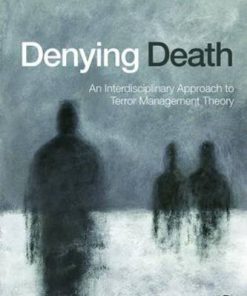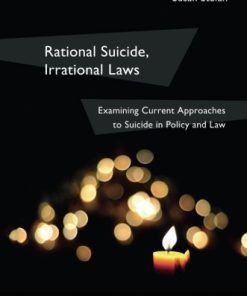Suicide An unnecessary death 2nd Edition by Danuta Wasserman 9780191026843 0191026840
$50.00 Original price was: $50.00.$25.00Current price is: $25.00.
Suicide An unnecessary death 2nd Edition by Danuta Wasserman – Ebook PDF Instant Download/Delivery: 9780191026843, 0191026840
Full dowload Suicide An unnecessary death 2nd Edition after payment

Product details:
• ISBN 10:0191026840
• ISBN 13:9780191026843
• Author:Danuta Wasserman
Suicide
An unnecessary death
Approximately one million people worldwide commit suicide each year, and at least ten times as many attempt suicide. A considerable number of these people are in contact with members of the healthcare sector, and encounters with suicidal individuals form a common part of the everyday work of many healthcare professionals. Suicide: An unnecessary death examines the pharmacological, psychotherapeutic, and psychosocial measures adopted by psychiatrists, GPs, and other health-care staff, and emphasizes the need for a clearer psychodynamic understanding of the self if patients are to be successfully recognized, diagnosed, and treated. Drawing on the latest research by leading international experts in the field of suicidology, this new edition provides clinicians with an accessible summary of the latest research into suicide and its prevention. The abundance of new literature can make it difficult for those whose clinical practice involves daily contact with suicidal patients to devote sufficient time to penetrating the research and, accordingly, apply new findings in their clinical practice. In light of the WHO Mental Health Action Plan 2013-2020, this new edition is a timely contribution to the field, and a vital and rapid overview, that will increase awareness of suicide prevention methods.
Suicide An unnecessary death 2nd Table of contents:
Section I: Epidemiology
1. Suicide in the world
Epidemiology
Methods of suicide
Data quality
Suicide attempts
Preventing suicide
References
Section II: Theoretical models of suicide behaviour
2. Stress-vulnerability model of suicidal behaviours
Stress-vulnerability model
The role of biology in a suicidal diathesis
Stress-biology and the diathesis
Offsetting the diathesis and building resilience to stress
References
3. The suicidal process
Classification of suicidal behaviour
The suicidal process in the context of the stress-vulnerability model
Suicidal communication
Poor communication by suicidal people
Conversation as a means to reduce anxiety and chaos
Types of suicidal communication
Direct verbal communication
Indirect verbal communication
Direct non-verbal communication
Indirect non-verbal communication
Response of significant others
Empathy of surrounding people
Ambivalence of surrounding people
Aggression of surrounding people
The life-saving actions of surrounding people
In-depth studies
Protective factors
References
4. Neurobiology of suicide and attempted suicide
Introduction
Evidence that there are familial and genetic factors that contribute to the risk of suicidal behaviour
Biological correlates of attempted suicide
Genetic correlates of neurobiology and suicidal behaviour
Biological correlates of completed suicide
The role of aggression and impulsivity in suicide risk
Conclusion
References
5. Social dimensions of suicide
Introduction
Social environment in general
Family relationships
Employment
Mobility and migration
Culture and religion
References
Section III: Risk groups for suicide
IIIA Psychiatric disorders
6. Depression, bipolar disorders, and suicide
Introduction
Major depressive disorder
Melancholia
Depression in males
Masked depression
Dysthymia
Bipolar disorders and mania
Comorbidity
Medical consultations before suicide
Antidepressants as means of committing suicide
Treatment
Prevention
References
7. Alcohol, other psychoactive substance use disorders, and suicide
Introduction
Alcohol use disorders
Substance use disorders
Suicide risk
Suicidal process
Comorbidity
Diagnosis and treatment
Medication
Psychosocial support and psychotherapy
Access to alcohol
What should be done?
Pay attention to heavy drinkers in risk situation
Improve diagnostics, treatment, and organization of care
References
8. Anxiety and suicide
Anxiety symptoms
Depression and anxiety
What is the evidence that severe anxiety is an acute risk factor for suicide?
The assessment of anxiety severity
Responding to a finding of severe anxiety
Conclusion
References
9. Eating disorders and suicide
Anorexia nervosa
Bulimia nervosa
Suicidality
Comorbidity
Prevention and treatment
References
10. Adjustment disorders and suicide
References
11. Suicide risk in schizophrenia
Risk factors
Methods of suicide
Managing suicide risk with antipsychotic medication
Managing suicide risk with psychotherapy and psychosocial interventions
References
IIIB Personality disorders
12. Personality disorders and suicide
Introduction
Borderline personality
Antisocial personality
Narcissistic personality
Histrionic personality
Obsessive–compulsive personality
Other personality traits
Childhood moulding
Genetic make-up
Suicide risk
Comorbidity
Treatment
Pharmacological treatment
Psychotherapy
Prevention
References
IIIC Somatic disorders
13. Physical illnesses and suicide
Health-care staff taken by surprise
Physical illness and suicide risk
Physical illness and the suicidal process
Physical illness and comorbidity in completed suicide
Suicide prevention through treatment of somatic diseases
References
Section IV: Risk situations for suicide
14. Negative life events and suicide
Introduction
Traumas
Violence, physical and mental abuse
Negative life events
Actual and threatened losses
Loss of a significant other
Loss of a national or cultural affiliation
Loss of health
Hospitalization
Temporary leave from hospital
Discharge from hospital
Loss of health or life by significant others
Loss of employment, study opportunities, home and financial position, and fear of change
Relationship problems
Change in activities due to public holidays
Changing phases of life
Change caused by contravention of law or norms
Change caused by imprisonment
War and natural disasters
Narcissistic injury
Sexual and gender minorities and suicidal behaviours
References
15. Suicidal people’s experiences of trauma and negative life events
Early years leave their mark
Lack of self-love
Shame
Narcissistic injury
Anger and rage
Guilt
Despair and hopelessness
Paradoxical behaviour
Suicidal people’s ambivalence can be used to save their lives, not to hasten death
References
16. Attempted suicide as a risk factor for suicide
Introduction
Risk factors for completed suicide
Clinical challenges
Hospital treatment
Suicide attempts in the elderly
Young suicide attempters
Outpatient treatment
References
17. Immigrant populations and suicide
Introduction
Suicidal behaviour in immigrant groups in Europe
Specific factors in suicidal behaviour
‘Culture conflict’ and ‘culture shock’
Refugee mental health
Prevention and management strategies for suicidal behaviour in immigrants
Assessment of suicide risk in immigrants
A personalized approach to suicidal behaviour in immigrants
Conclusion
References
18. Suicide in the criminal justice system
Introduction
Socio-demographic characteristics
Psychiatric diseases
Suicide risk assessment and treatment of prisoners
Effective programmes for suicide prevention in prison
Conclusions
References
19. Suicide in the armed forces
Introduction
Durkheim’s explanations of military suicide and comparative rates
General and specific risk factors
Combat stress and suicide in combatants
Suicide in war veterans
Young soldiers’ suicidal behaviour
Protective factors and suicide prevention in the armed forces
References
Section V: Age-related suicide
20. Adolescent suicide and attempted suicide
Epidemiology
Risk factors for youth suicide
Depression
Bipolar disorder
Schizophrenia
Alcohol and drug abuse
Eating disorders
Psychological characteristics of adolescent suicide attempters
Impulsivity
Anger
Anxiety
Psychodynamic aspects of adolescent suicide
Clinical assessment of suicidal risk
Treatment
Acute management
Hospitalization
Discharge home
Long-term treatment management
Psychotherapy
Psychopharmacology
Lithium
Antidepressants
Anxiolytics
Prevention of suicidal behaviour
References
21. Older adults and suicide
Prevalence of suicidal behaviours
Risk factors
Psychiatric disorders
Personality traits
Physical health problems
Hospitalization and contact with health services
Socio-economic status
Social isolation and loss
Long-term care
Emerging issues
Sars
Dementia
Homicide-suicide
Suicide prevention
References
Section VI: Suicide risk assessment
22. Suicide risk assessment
Systematic clinical assessment of suicide risk
The suicidal process
Suicidal communication
Relationships
Psychosocial situation
Mental illnesses and personality disorders
Substance misuse
Somatic illness
Suicide risk assessment after suicide attempts
Suicide risk assessment before temporary discharge
Previous psychiatric care and the patient’s attitude towards care
Respect for suicidal patients’ wishes
Assuming professional responsibility
Reducing and gauging risk of suicide
After completion of suicide risk assessment
References
23. The suicidal patient–doctor relationship
Introduction
The suicidal patient’s transference
Interaction between the suicidal patient’s and doctor’s ambivalence
Patients may hide their needs
The doctor’s countertransference
Role assigned to the doctor
Difficulties in suicide risk assessment
References
24. Heuristics and biases in suicide risk assessment
Introduction
Anchoring
Representativeness
Confirmation bias
Availability
Base-rate neglect
Overconfidence bias
Sunk cost
Discussion
References
25. Psychometric scales in suicide risk assessment
Introduction
Selection of psychometric scales specifically measuring suicidal risk
The Suicide Intent Scale
The Scale for Suicidal Ideation (SSI-C)
The Beck Hopelessness Scale
The SAD PERSON Scale
The role of internalized hostility (interpersonal sensitivity, anxiety, self-depreciation)
The role of externalized hostility (impulsivity or risk-taking behaviour)
WHO-5 as a screening tool in the suicidal process
The here-and-now assessment of suicide risk: the Columbia Suicide Severity Rating scale (C-SSRS)
Combining scales to assess suicide risk
Conclusion
References
26. Strategies in suicide prevention
Attitudes towards the suicide-prone person
Taboos as psychological defence mechanisms
Suicide-prevention programmes
Strategies in suicide prevention
Health-care approach
Public health approach
Psychosocial support
Public attitudes and knowledge
Environmental measures
Networks
Research
References
Section VII: Suicide prevention
VIIA Health-care perspective
27. Pharmacological treatment of underlying psychiatric disorders in suicidal patients
Introduction
Abnormal reactions to common psychosocial stressors
Anxiety disorders
Unipolar and bipolar depression
Schizophrenia
Personality disorders
References
28. Psychological treatments for suicidal individuals
Introduction
Longer-term interventions
CBT for suicide prevention
The evidence base for CBT-based approaches to prevent suicide
Dialectical Behaviour Therapy
The evidence base for DBT
Other approaches with demonstrated efficacy or effectiveness in reducing suicide risk
Collaborative assessment and management of suicidality (CAMS)
Interpersonal psychotherapy (IPT)
Psychodynamic approaches
The combination of psychotherapy and psychopharmacotherapy in the treatment of suicidality
Brief interventions
Combined interventions
Manual-Assisted Cognitive Therapy (MACT)
Directions for future research: considerations for developing and testing treatments to prevent suicidal behaviour
Clinical implications
References
29. Education of general practitioners in depression and suicide prevention
The Gotland study
The Gotland Male Depression Scale (GMDS)
International experience
The need for continuous training
References
30. Collaboration between psychiatrists and other physicians
Suicide in different medical settings
Suicide-prevention team
Cooperation with somatic physicians
Patient–physician relationship
Referral for psychiatric evaluation
When to hospitalize a suicidal patient
Emergency admission and admission to an intensive care unit
Contact with relatives
Follow-up and treatment planning
Suicide on the ward
Continuous training
New developments
References
31. The work environment for health-care staff
Vulnerability of psychiatric staff
Sound routines keep chaos and anxiety in check
Support for staff after a suicidal act of the patient
Immediate routine measures
Contacts with relatives
Immediate emotional support for staff
Developing knowledge after the suicidal event
Training and supervision
Enhancing the quality of suicide-preventive work
References
32. A psycho-educational perspective on family involvement in suicide prevention and postvention
The importance of the family in the provision of care
Psycho-educational resources for families after a suicide attempt
Practical considerations for family involvement in care and treatment of at-risk individuals
After a suicide
An integrative, supportive, and educational approach after suicide
Role of the therapist
References
VIIIB Public health perspective
33. Perestroika in the former USSR: history’s most effective suicide-preventive programme for men
Perestroika: reduced alcohol consumption and a hopeful social climate
Suicides decreased
Suicide rates increase when alcohol restriction ends
Alcohol restrictions reduce suicides
Alcohol restrictions have different effects in different countries
Alcohol restrictions reduce suicides among alcoholics
Treatment of psychiatric disorders should accompany diminished access to alcohol
References
34. Controlling the environment to prevent suicide
Rationale
Regulation of firearms
Control of pesticides
Control of carbon monoxide
Vehicle exhaust gas
Charcoal burning
Reducing availability of medications
Hanging
Barriers at jumping sites and hotspots
Controlling access to railways and subways
Media reporting
Suicide clusters
Safe clinical practice
Conclusions
References
35. Suicide prevention through the Internet
Introduction
The SUPREME project (suicide prevention through Internet and media-based mental health promotion)
Youth involvement in the website development
Online tools and content
Website design
Website functions
Online safety and building trust with the users
Promotion
Evaluation of the website
Conclusion
References
36. Suicide prevention in schools
Suicide prevention: the earlier, the better
School as an arena for promotion of mental health and prevention of suicide
Mental ill-health and suicidal behaviour among school pupils
Knowledge and attitudes can be influenced
Suicidal behaviours and adolescents
Monitoring risk behaviours
Suicidal behaviours can be prevented
Conclusions
References
Author index
Subject index
People also search for Suicide An unnecessary death 2nd:
death danuta wasserman
danuta wasserman
danuta wałęsa
a death worse than fate
o death – jen titus
You may also like…
Politics & Philosophy - Social Sciences
Motivation Effort and the Neural Network Model Theodore Wasserman
Politics & Philosophy - Anthropology
Politics & Philosophy - Social Sciences
Relationships & Lifestyle
Politics & Philosophy - Politics
Suicide by Democracy An Obituary for America and the World Michael Starks
Politics & Philosophy
Politics & Philosophy - General & Miscellaneous Philosophy
Politics & Philosophy
Suicide by Democracy an Obituary for America and the World 3rd Edition Michael Starks











